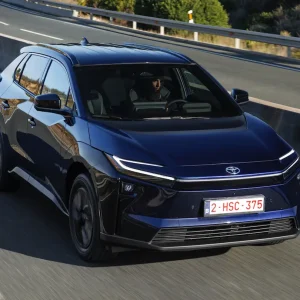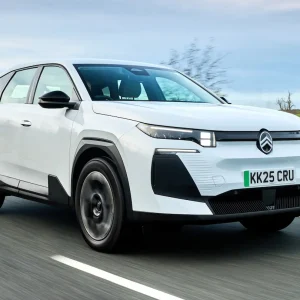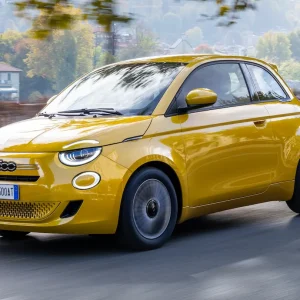As Audi’s first plug-in hybrid A8 ever, a lot is at stake. Some 40% of all UK A8s are registered to businesses and 20% of the overall annual total (823 in 2019) could become PHEVs. So first the business-related headlines: the plug-in hybrid A8 e has a claimed 28 miles of pure-electric range plus a 60g/km CO2 rating equating to a super-low-for-a-limo 15% BIK band despite offering 449hp and a 4.9-second 0-62mph time. The feel-good factor with the A8 e is certainly present. Although our test vehicle was a stealthy black – technically Vesuvius Grey metallic – and this generation of the model in non-plug-in guise has been on UK roads since 2018, the A8 e still garnered a major crowd reaction. Thank the PHEV-specific daytime running lights around the front-edge air intakes and also, I suspect, the Star Trek-ish spacey noise emitted to alert other road users of the A8’s presence at low speeds.
Inside, the new A8 e feels as special as any top-end Audi should. There’s a head-up display and four colour screens: a 12.3in driver display, 10.1in upper and 8.6in lower touchscreens, plus a 5.7in removable tablet controller in the rear so those chauffeured can adjust aircon and music remotely. All are superbly integrated into the design with flush surfaces and fine finishes.
The hybrid powertrain offers a really smooth transition between electric and petrol propulsion too and the car is amazingly rapid when the driver requests it. It can stay in EV mode up to 84mph and has a luxurious ride quality, adaptable via various driving modes, which also affect the accelerator pedal’s kick-down point where the petrol engine takes over from electric-only driving. For example, in Sport mode the accelerator only has to be depressed to 40% of its potential pedal travel while in Efficiency mode it’s 90%.
In other words, a light driver’s foot keeps things electric for longer, which is just what we opted for in the few times we went out – one long journey immediately before lockdown and another as it started to ease. In between those two missions we did recharge the battery once, which gained us a notional 25 electric miles in 2.5 hours from a pay-as-you-go local street light plug-in point. Employing a gentle driving style allowed us to travel 22 miles in two separate journeys on electric power only (via a button easily found in the upper touchscreen and pressed to deliberately stay in EV mode). After that electric-only session, short-term economy was 124.0mpg, but without recharging again that figure soon reverted to 30.5mpg.
The A8 e avoids the London Congestion Charge until October 2021, after which the car will have to pay the full daily fee, but its electric-only mode could remain a reassuring environmental aspect to its well-heeled patrons visiting city centres. Assuming they’ll be sitting in the back they will enjoy great comfort for the ‘basic’ nearly £90,000 A8 e long wheelbase, but can still shell out further four-figure sums for extra pack options, which include a premium Bang & Olufsen sound system, acoustic double-glazed rear glass, footrests and electrically adjustable rear seats.
Despite this impressive package, the A8 is far from the sector sales leader. Both its German rivals also offer plug-in limos – the market-dominating and pricier Mercedes S-Class and a new BMW 7 Series (the one with the big grille) – plus there’s the elegant regular hybrid Lexus LS and even a run-out edition of the Jaguar XJ, although in long-wheelbase guise it’s only available in the UK with diesel power now. Running costs-wise the A8 just shades it according to KeeResources, with a 107.2p per mile figure, compared to the BMW 7’s 115.2p. Both are considerably cheaper to run than the older Mercedes S-Class (122.5p), although the Lexus LS at 109p per mile looks an appealing alternative. Interestingly though, the diesel A8 L 50 TDI has the best cost per mile out of all these rivals at 102.7p, based largely on being some £13,000 less to buy and suffering £10,000 less depreciation. On a practical note, it also has a bigger boot – 505 litres versus 390 for the A8 e. PHEVs aren’t for everyone it seems then, and come at a high price for first owners, despite the undoubted tax breaks. To see if they make sense for your business, make sure regular recharging is a feasible reality and do your sums.
Audi A8 L 60 TFSI e quattro Sport tiptronic
P11D: £88,125
Residual value: 30.8%
Depreciation: £60,975
Fuel: £3,359
Service, maintenance and repair: £2,587
Cost per mile: 107.2p
Fuel consumption: 108.6mpg
CO2 (BIK band): 60g/km (15%)
BIK 20/40% a month: £220/£441
Boot space: 390 litres
Engine size/power: 2,995cc/449hp





